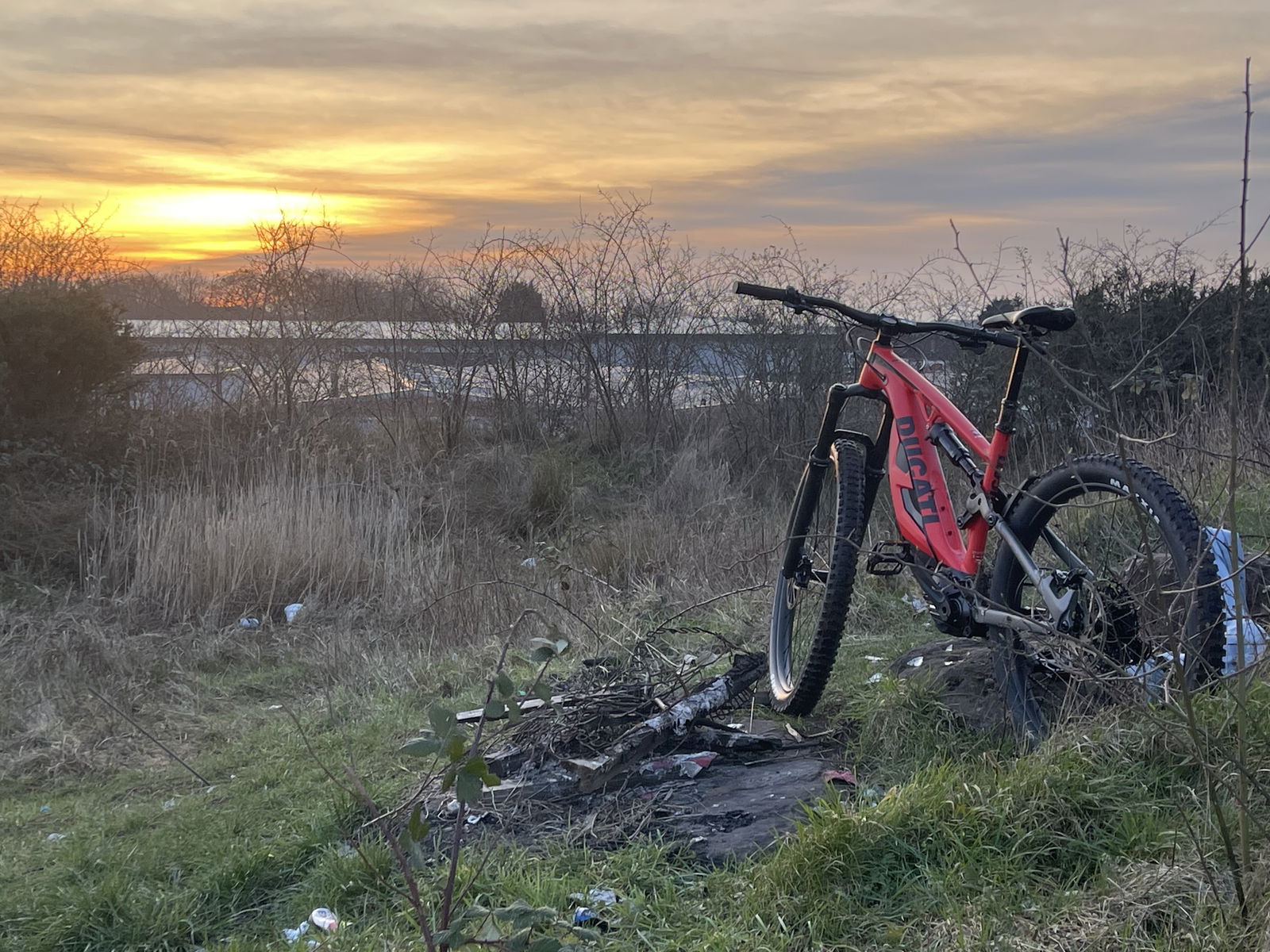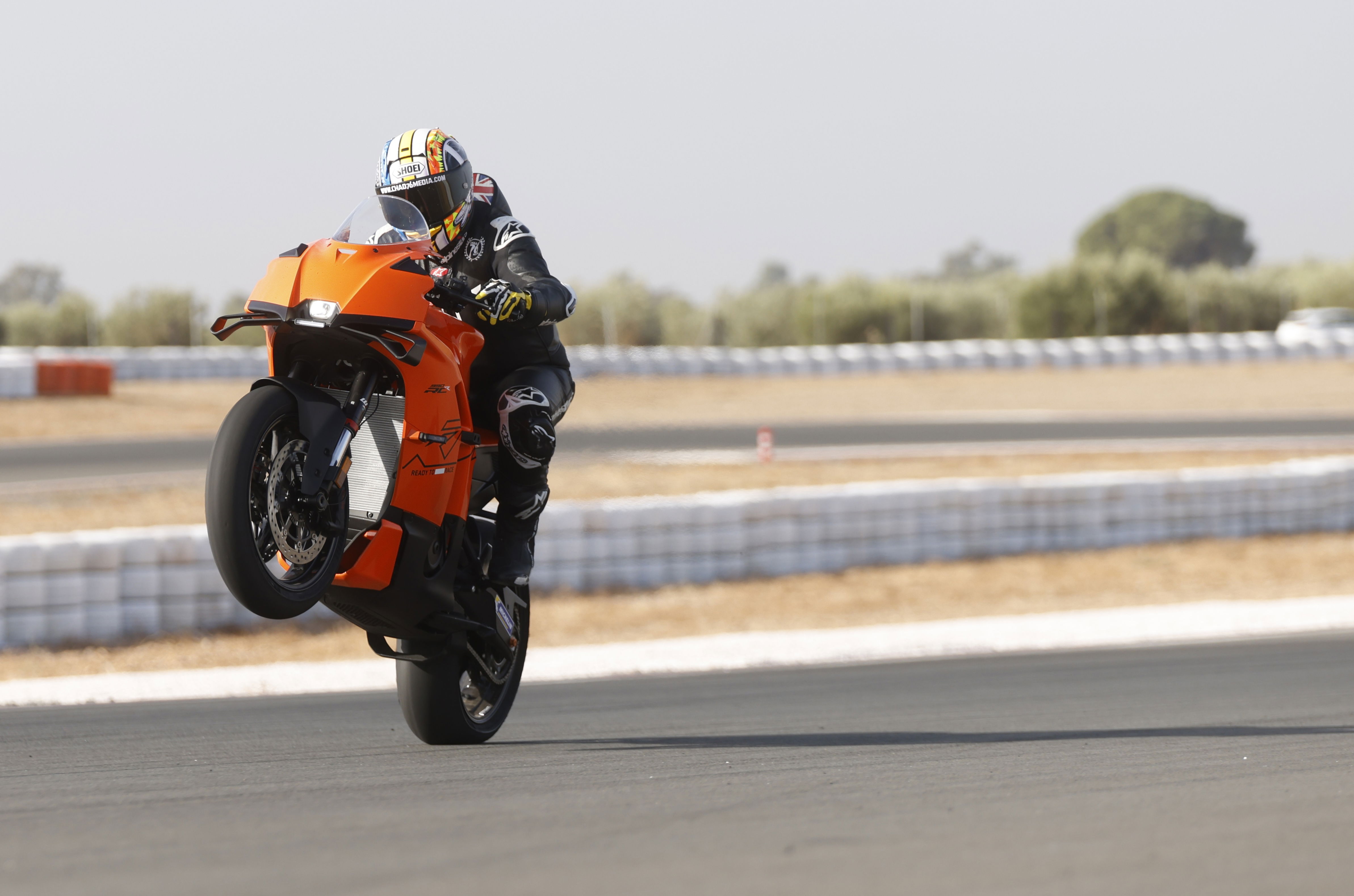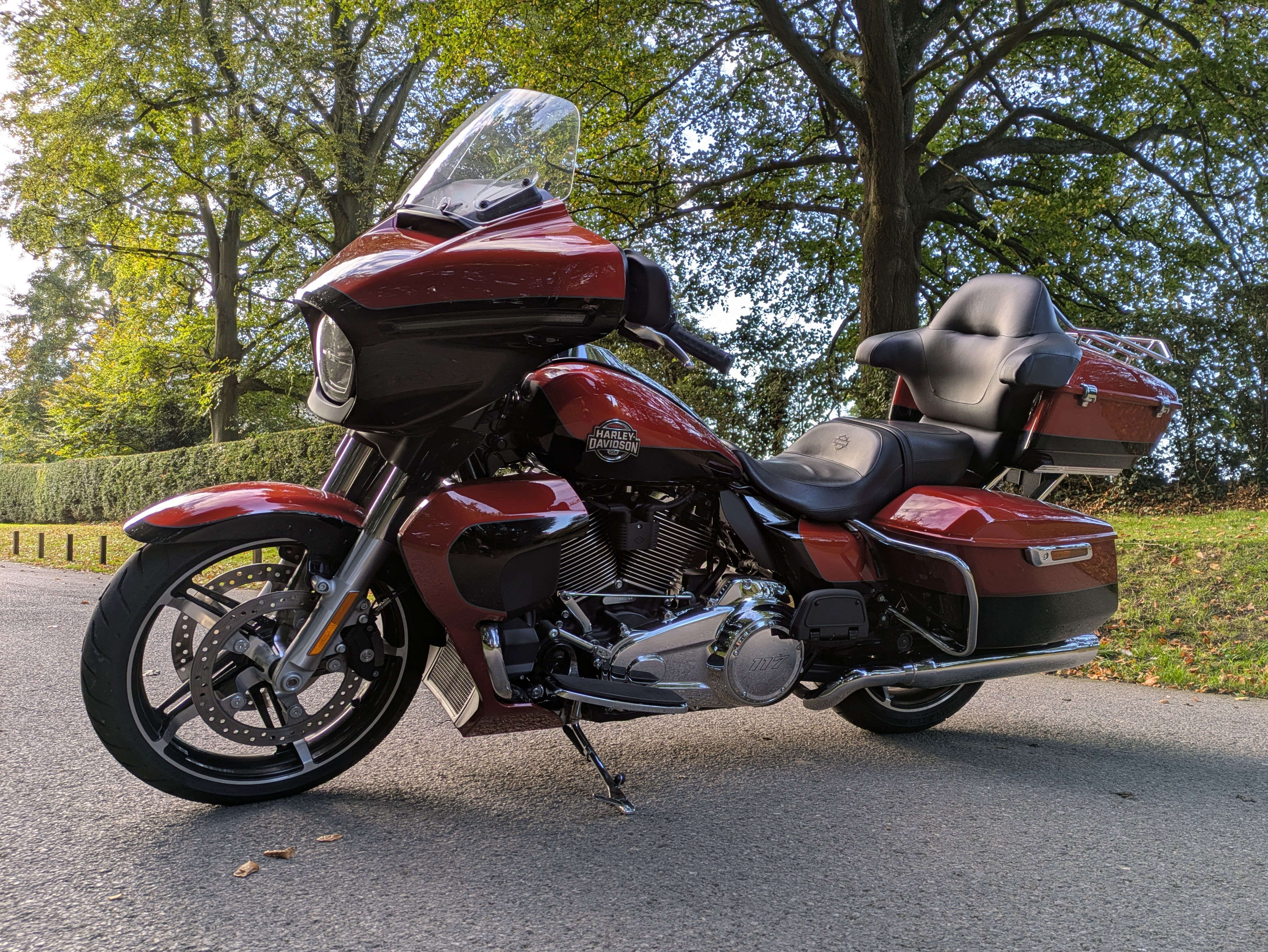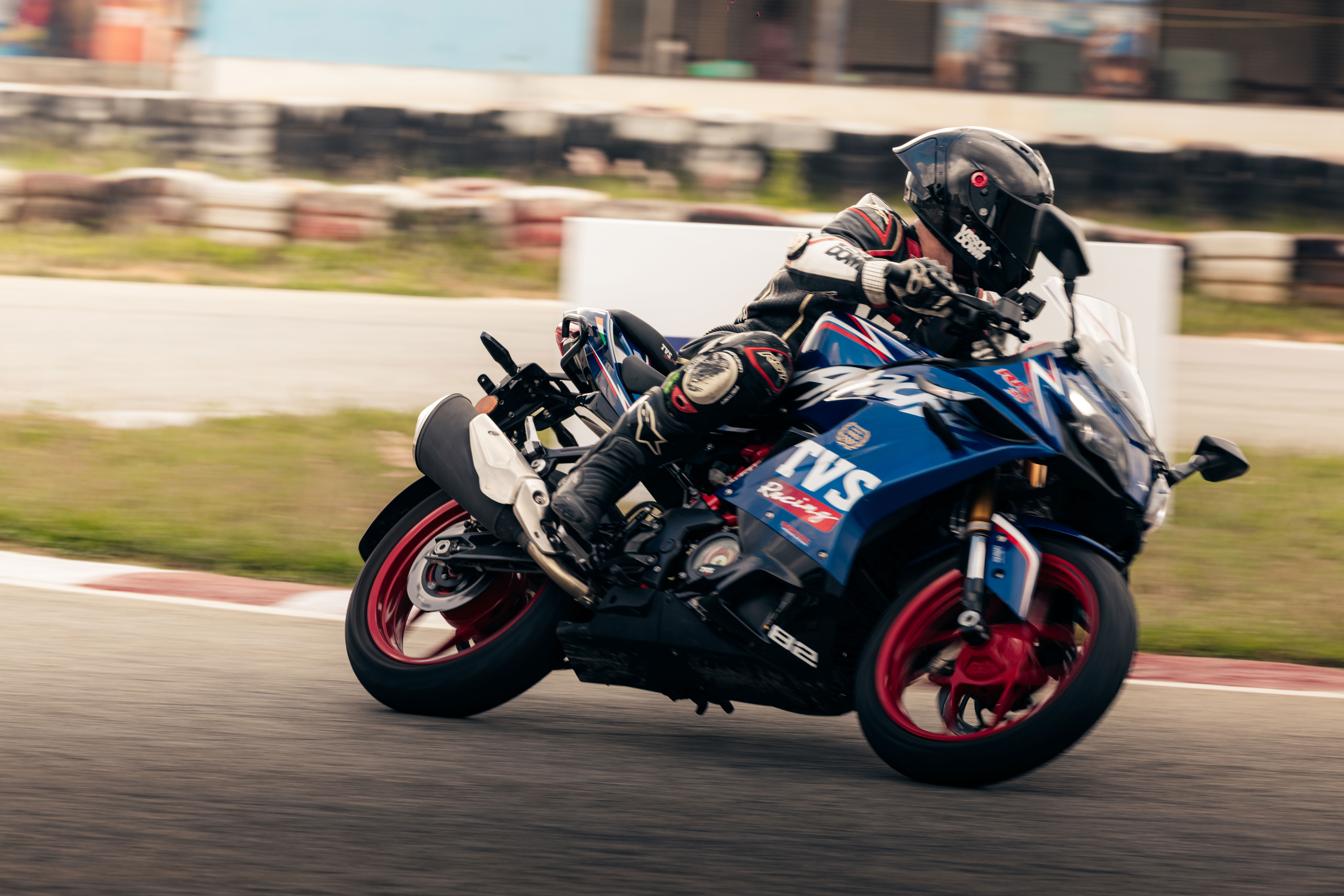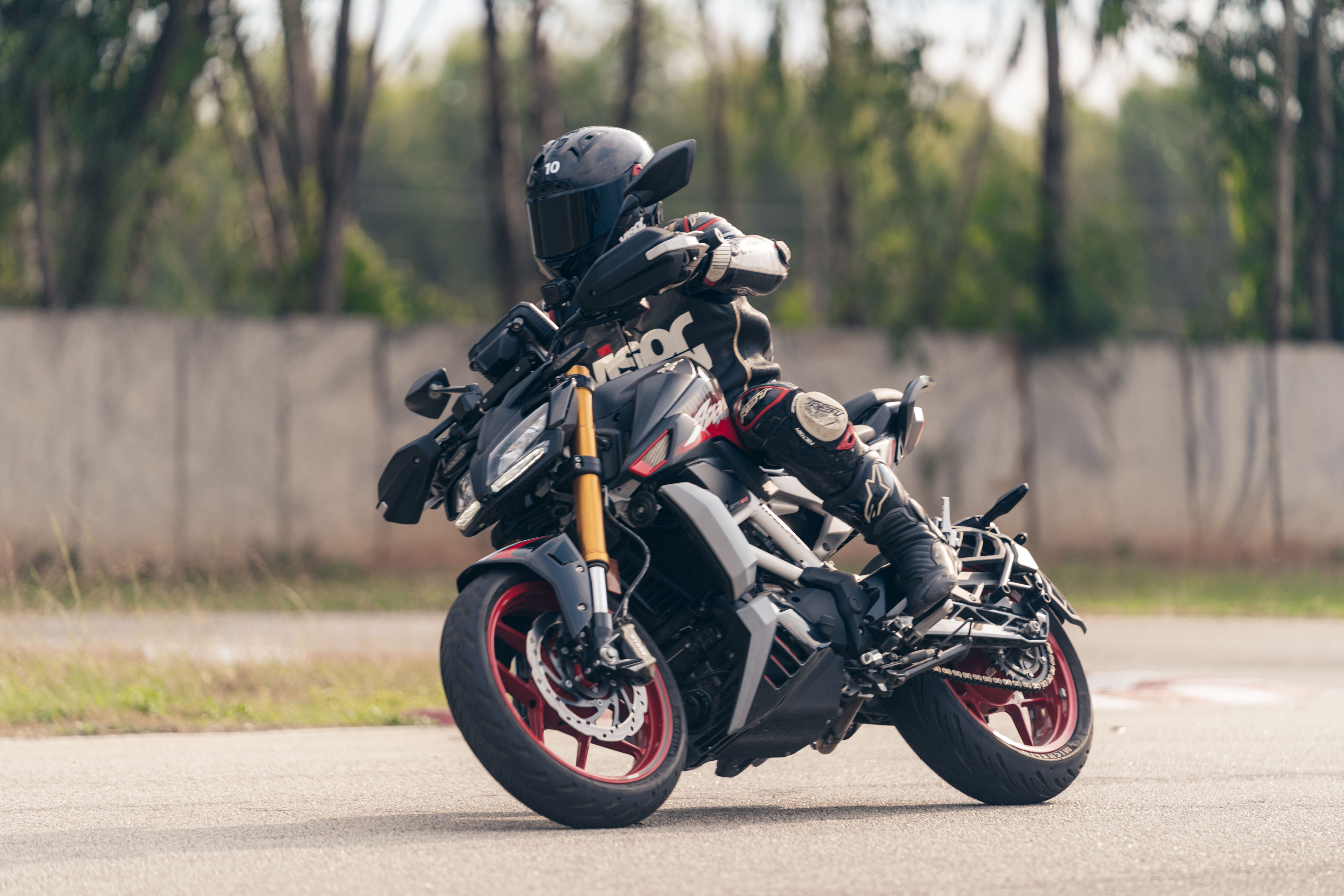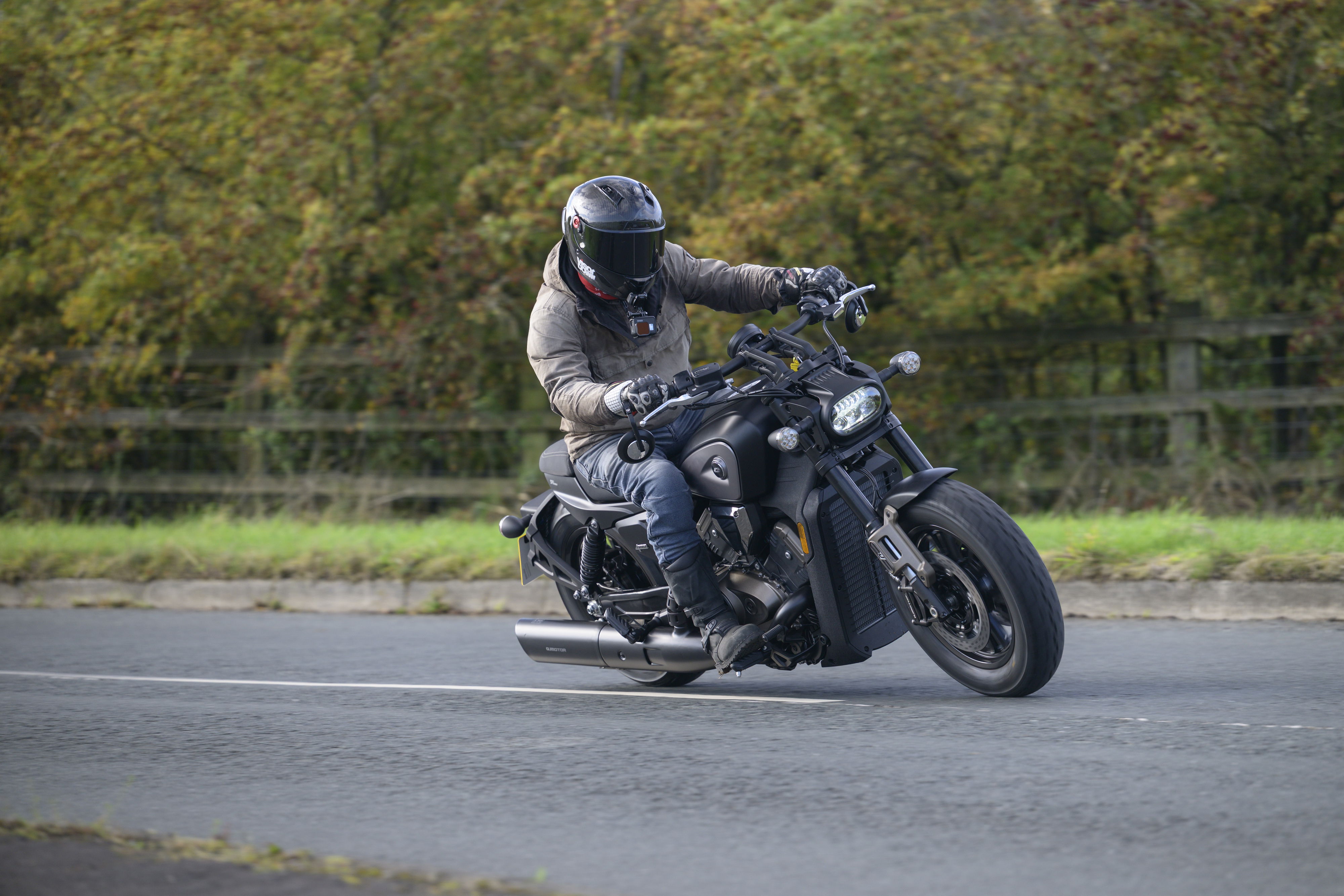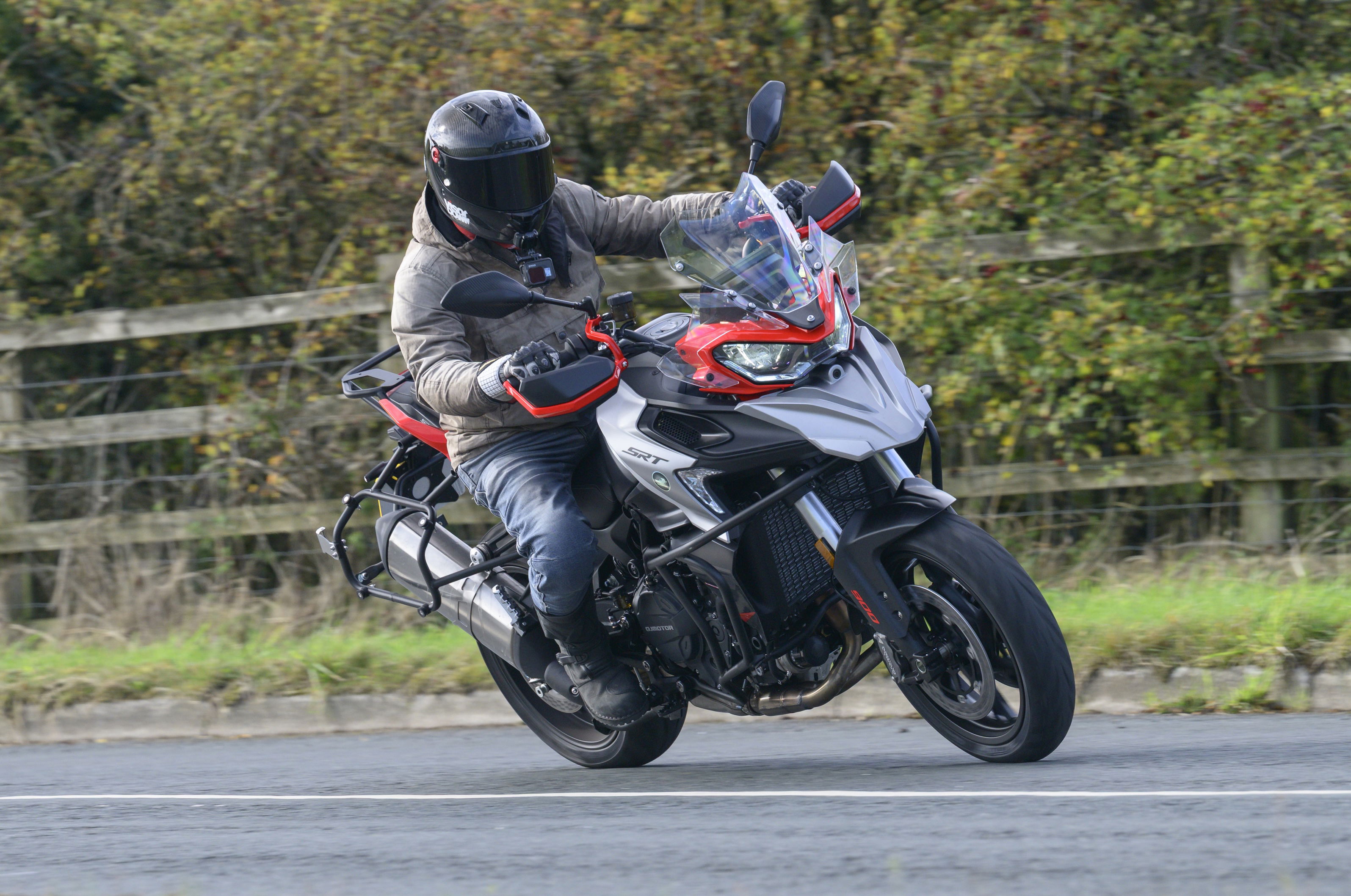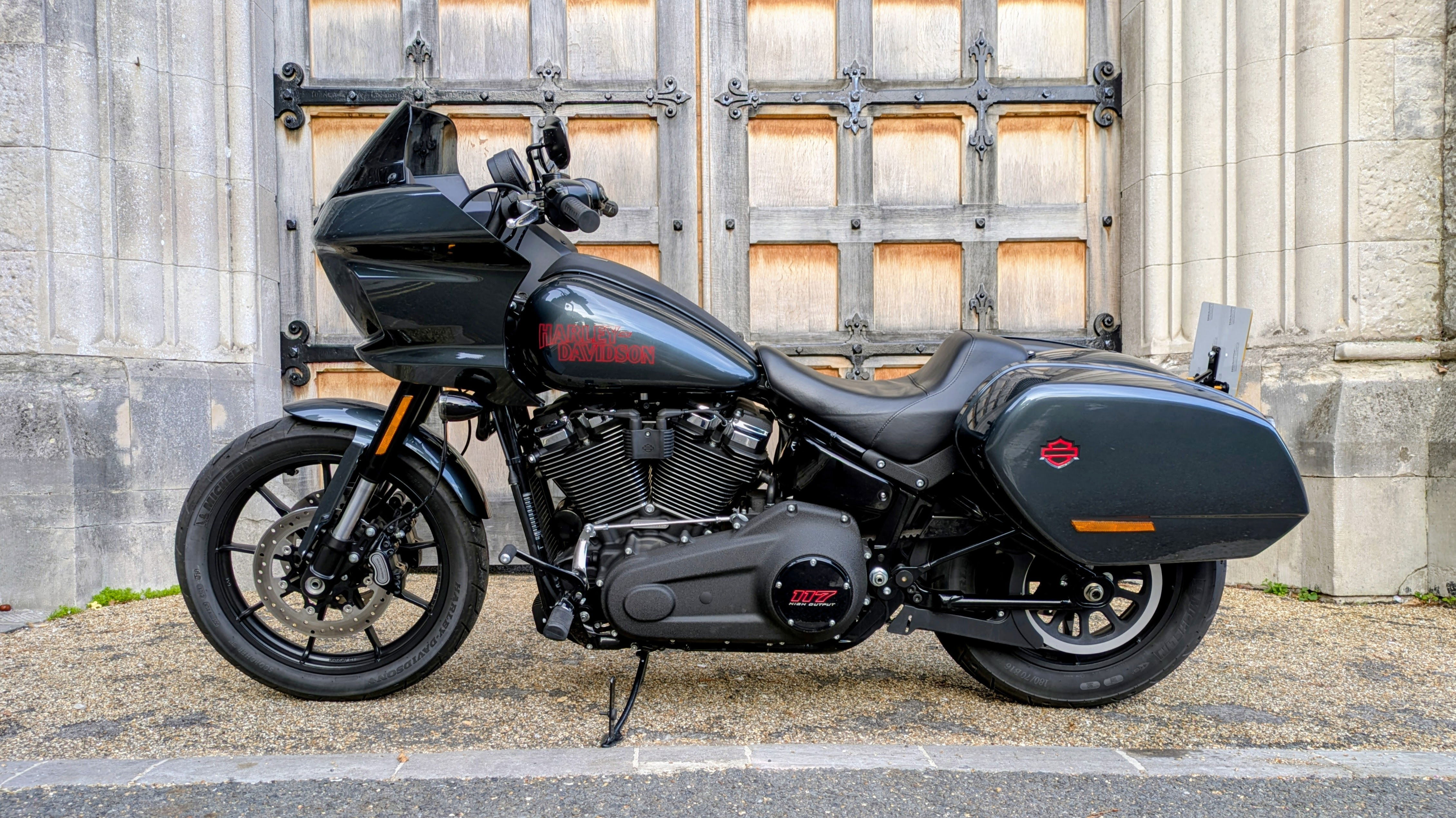2023 Honda XL750 Transalp review and Plus Pack accessories tested
The Honda XL750 Transalp is back and we flew out to Portugal for an on and off-road test of the middle-weight adventure bike
.jpg?width=1600&aspect_ratio=16:9)
WE first clapped eyes on the new 2023 Honda XL750 Transalp at EICMA in November 2022… Well, actually that is a lie, we saw it about a month before that, when an eagle-eyed snapper with a big lens pictured it while Honda was shooting the promo pictures!
But I digress, a new middle-weight ADV machine from Honda was arriving, and looking at the thing on the stage in Milan, I liked what I saw. It was the first time I’d seen the Transalp and 2023 Honda CB750 Hornet, in the flesh. And while still distinctly Honda – plus some parts-bin rummaging (see the headlight from a CB500X…) – on paper, they both looked great.
Lighter than much of the competition, power output that is right in the ballpark, and a price tag that even had Suzuki stalwarts asking ‘WTF?’. We’ve already had a chance to sample the CB750 Hornet, and its impressive mix of handling dynamics and punchy delivery really entertained me at the global press launch. So you can imagine my delight when the Transalp invite slid its way into my DMs.
For a full price breakdown of the new Transalp, check out this page which includes a PCP example and comparison against the rivals.
We have also managed to test a bike here in the UK, which not only gave us the chance to try the bike out on home ground, but also to test a fully accesoried version of the bike. It included the Plus Pack of addons, along with the very nice quickshifter and bear-trap footpegs. To check out that review hit the Jumplink below, to read the original launch report read on.
Honda XL750 Transalp Plus Pack review
.jpg?width=1600)
What is the 2023 Honda XL750 Transalp
First up, this isn’t a Hornet with long-travel suspension hung at each end. The Frame is vastly different, being beefier at the front and featuring a new, longer and stronger sub-frame bolted on the rear. Think of it like this, the only real thing the two bikes share is the engine. And maybe that headlight they inherited from an older sibling. That new frame weighs in at an impressive 18.3kg which, while being more than I could bench-press, does equate to 10 percent less than the weight of the frame found on the Honda CB500X. You shouldn’t need reminding of the fact that that bike has a hell of a lot less power, torque, and off-road ability than this new machine.
.JPG?width=1600)
And while the Honda XL750 Transalp is well known as a bike that helped to drive forward the adventure motorcycle sector in those burgeoning years, Honda isn’t billing this as a full-on ADV machine. Yes, it has a 21” front wheel, long travel suspension (200mm front and 190mm at the rear), 210mm of ground clearance and a bespoke mode for off-road work. But even looking at the itinerary of the launch, I could tell Honda was hedging its bets with this one. It consisted of around 100 miles, with about four of those spent sliding about in the muddy stuff. Taking that into account, to me, this is an 80/20 adventure bike. 80 percent on-road riding, 20 percent off-road.
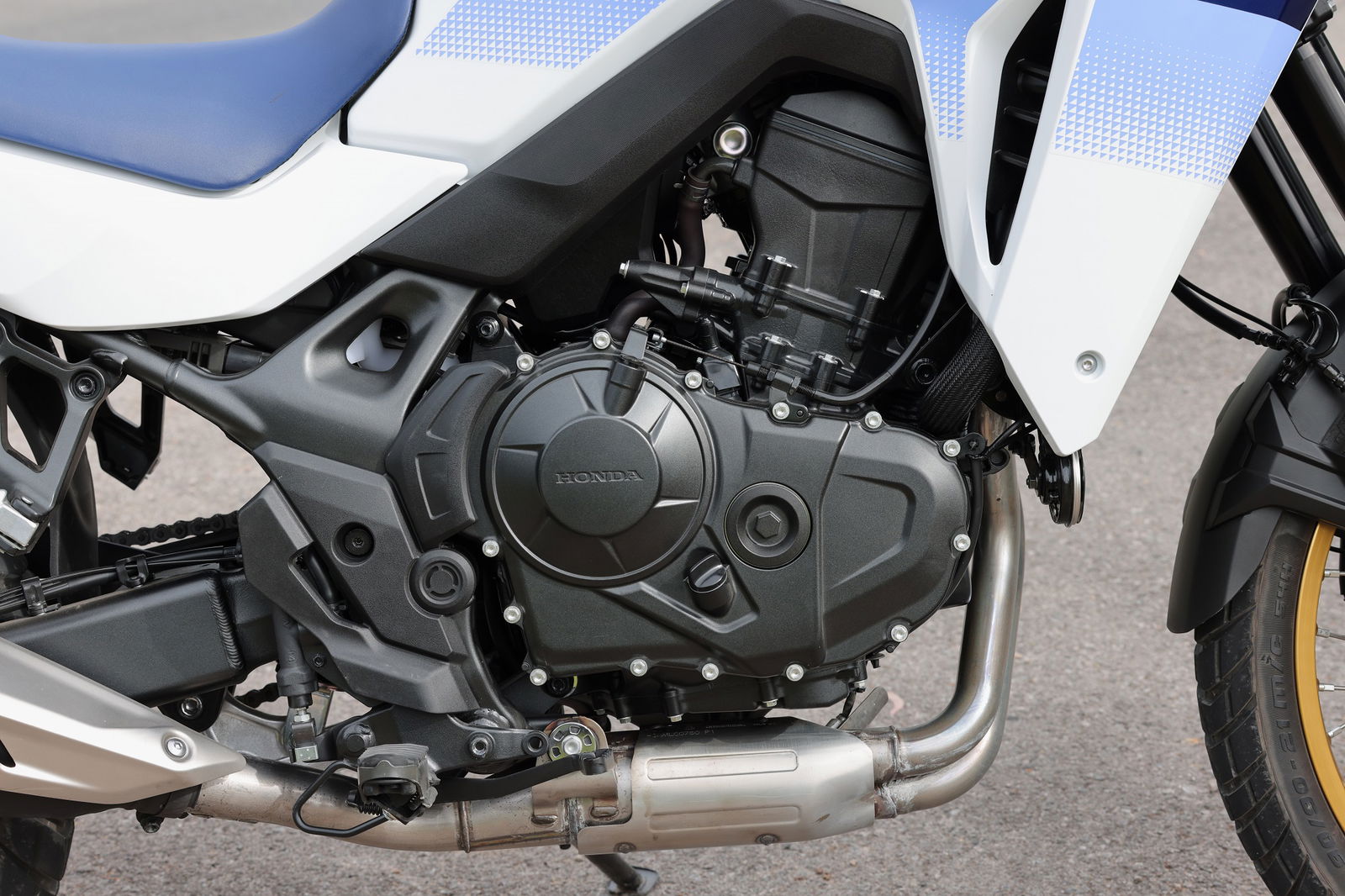
2023 Honda XL750 Transalp engine
Having already ridden the new 750cc 270-degree twin from Honda, I had an idea of what to expect. In the Hornet, it’s punchy in the mid-range and races to the redline like a demented banshee. On the twisting B-roads of the Hornet launch it was massive fun, only let down by a slightly snatchy throttle in the first few degrees of operation. In the Transalp though, it feels very different. The intake is longer, creating a deeper and richer intake noise while boosting low-end grunt. And Honda has (thankfully) tweaked the ride-by-wire throttle which I have to say is much easier to live with than the naked sibling. In the Transalp, the engine pumps out 90bhp and 55lb-ft of torque. That short-stroke engine does things that the spec sheet shouldn’t allow, and while you’d think an 87mm x 63.5mm architecture would make for a very peaky delivery, with this new mapping and intake, it really doesn’t. The Transalp, like the Hornet, can be ridden in a number of ways, either dance around the box like a wannabe racer, or stick it in third and ride the low and mid-range grunt out of slower corners.
The bikes we rode on the launch were equipped with some genuine Honda accessories, one of which was an up-and-down shifter and blipper. Snicking through the six-speed gearbox I had no complaints and should you find the shift a bit abrupt, you can dial into the TFT and soften the shift to your heart's content. Like most modern ADV bikes, a slipper clutch is present, and it does a decent job of gathering up the torque on the road, when we hit the dirt though, it seemed to me to be slightly too tight. Not a huge issue though, given the points I make above regarding the bikes designation.
.jpg?width=1600)
2023 Honda XL750 Transalp brakes, suspension, and handling
With 43mm Showa SFF-CA USD forks at the front, and a Showa Pro-Link shock at the rear, the on-road handling of the Transalp is bloody fantastic. I’ve never ridden an adventure bike that tracks through a corner quite like this thing does. It’s got a 21-inch front wheel but doesn’t have a hint of sluggishness in the way it makes it flicks from side to side. The bars are feather-light, and I mean feather-light. Be you moving the bike around off the stand or pootling through town, It feels like some otherworldly motorcycle power-steering is in action here.
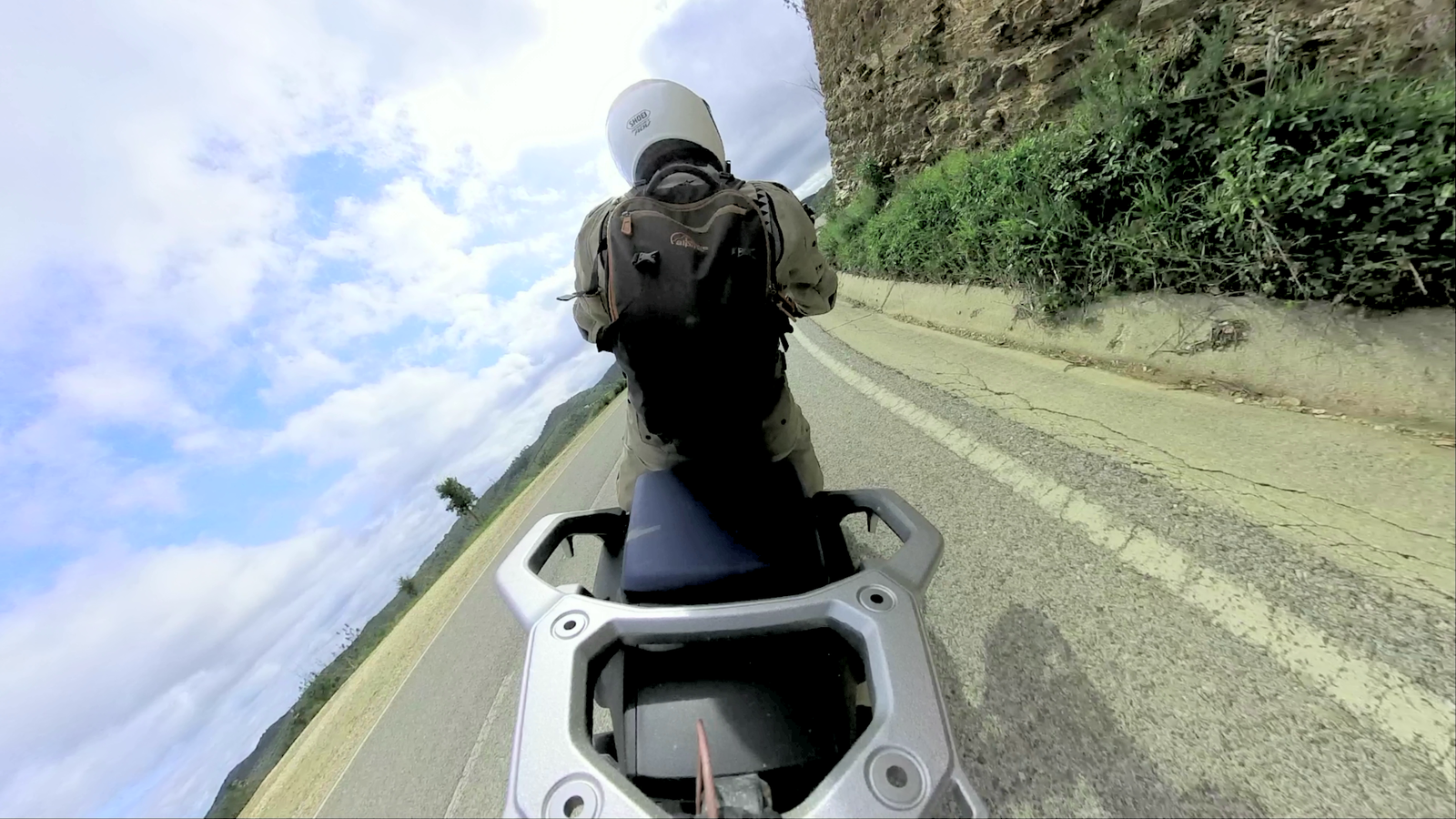
Out on the sweepers that crisscross the Algarve, the 208kg bike dances through fast direction changes eagerly. When you exit the corner, crack open the throttle and you be hurtled at the horizon at a serious rate of knots. And when you reach the next hairpin you’ll haul on the Nissin brakes and the 310mm wavy discs will drag the front tyre into the road, the front forks soak up the energy and the Metzeler hoops will lock the bike to the road. It’s super stable on the brakes, despite that featherweight steering and only when you get the ABS chiming in will you feel the front end start to complain. Once you get to the apex (and you almost certainly will) release the brake, push the bike on its side and then crank on the throttle to do it all again in the next hundred yards.
_0.JPG?width=1600)
In my mind, the absolute best attribute of the Transalp is its handling. It is unquestionably one of the best, quite possibly the best handling ADV machine for fast road riding. And while that sounds like an oxymoron, like taking a Land Rover on a trackday, when you think back to where this bike is being pitched, it totally makes sense. If Honda really wanted to go after the KTM 890 Adventure, it most certainly could. But then the price goes up, the bikes get more complex, and the majority of potential owners (who will be looking at this as a road-going commuter/tourer) won’t get the best out of the machine. Plus, the original Transalp was never a hardcore off-roader. It was a tough and dependable do-it-all machine, just like the new model.
.jpg?width=1600)
2023 Honda XL750 Transalp off-road handling
At the halfway point of our press ride, we peeled off the Tarmac and onto a trail that in 2009 hosted the start of the Dakar Rally. After a minute or two of fiddling with riding modes, we set off on what turned out to be a slippery and wet off-road excursion. It took me a minute or two to get to grips with the handling of the bike, mainly that featherweight steering. It’s so light that even small changes in the surface have the bars wriggling, and while it never gets out of control, it took me a bit of time to get in a groove and let the bike do its thing.
.jpg?width=1600)
At 208kg ready to ride, the Transalp is very light, and that is something that really helps when riding off-road. It’s extremely nimble, and even on these 80/20 hoops did an admirable job on the slick surface. For off-road riding you’ll likely be in Gravel mode, although with the low power in that setting, we opted for the User mode where the power could be increased to full, the traction control reduced, and the rear ABS switched off manually. Even now, I still found the TC too intrusive, and even wrist stretching throttle use provoked little or no movement from the rear end – regardless of the lean angle I was at. After a couple of miles, I opted to switch off the system altogether and unshackled from the electronics the bike became much more dynamic, power sliding out of corners and feeling more like the playful machine I’d been riding on the road.
.jpg?width=1600)
2023 Honda XL750 Transalp comfort and accessibility
With uber-relaxed rider ergonomics, the XL750 is a very easygoing and comfortable bike to ride. The pegs (fitted with bear traps on the machines we rode) are perfectly positioned and even with the rubber inserts removed surprisingly vibe-free. The wide bars provide you with masses of leverage although in truth, don’t really need the help as the steering at any speed feels so light. The 850mm seat is expansive, with masses of room for a rider and passenger and it's nicely padded for all-day riding comfort. My only real gripe with the comfort is that the non-adjustable screen created quite a bit of buffeting at motorway speeds. If you are any taller than me, the accessory tall screen would be the top of my wish list.
.jpg?width=1600)
Another point to note is that when you do get up to motorway speeds, the Karoo tyres do hum quite a bit. It’s not awful, although I could imagine after a few hours of riding you’ll get off the bike and still hear that resonance for quite some time.
Comfort aside, the new Honda is supremely accessible, especially for people as vertically challenged as me. Being able to almost flat-foot on an ADV is not something I’ve experienced before, but having that security made riding the Transalp an absolute doddle whether I was on road or off it. And there is more to it than that, it’s not just the easy-going ergonomics, the bike is super easy to ride when you get up to speed. The gearbox is lovely, and the factory option quickshifter (with adjustability) works very well. The clutch is light, the brakes are strong yet progressive and the whole riding experience is very easy to live with. If you look at adventure bikes with some trepidation, the 2023 Honda XL750 Transalp might be just the kind of bike you need to ride.
.jpg?width=1600)
2023 Honda XL750 Transalp electronics
Like the Hornet we rode last year, the Transalp does without any cornering ABS although you do get a raft of other goodies to fiddle with. Riding modes cover Sport, Standard, Rain and Gravel, and there is a handy user mode you can set up as you desire. You get four engine power levels, three engine-braking levels, two levels of ABS and five steps of traction control including the ability to switch off the TC and rear ABS altogether. The TFT dash is lovely, with a proper digital rev-counter and needle or more modern themes to pick from.
.jpg?width=1600)
I only really had an issue with the electronics when it came to riding the bikes off-road. They are a bit on the safe side and even with the traction control at its lowest setting, you’ll be doing well to get any kind of movement from the rear wheel on dirt. You can of course switch off the TC, as I did after a couple of miles of off-road riding, but it’d be nice if the system was optimised for this kind of stuff. Bikes like the KTM 890 Adventure have electronics that flatter you once you get on a trail, allowing you to slide the bike up to a point before it is all gathered up and pointed in the right direction. The Transalp isn’t like that and you get the impression that it mollycoddles the rider keeping them away from any and all danger. Like the traction control, the ABS at the front isn’t really an optimised system for off-road riding, and while you can lean on the system a bit, it can become flustered on steep and muddy descents.
.JPG?width=1600)
What we like about the 2023 Honda XL750 Transalp
- The on-road handling of the bike is second to none
- The styling is great with nice colour and graphic options
- Comfort and accessibility are both excellent
What we didn’t like about the 2023 Honda XL750 Transalp
- Some more off-road optimised electronics would be nice
- A quickshifter as standard would be nice
.jpg?width=1600)
2023 Honda XL750 Transalp verdict
With a price point that is a shade under £10k, the new Transalp has set out a very competitive stall in the middleweight adventure segment, and regardless of how good it is to ride, it’ll likely fly off the shelves on that basis alone. But it’s not just another budget ADV machine with a parallel twin-cylinder engine, it’s comfy, quick and fantastically easy to ride. The negative points I mentioned above aren’t really the fault of the bike either, they are down to where Honda is pitching its latest adventure touring bike. Sure, they could have upgraded the tech and bolted on a quickshifter as a standard, but then that entry-level price would place it nearer the competition from KTM, Suzuki and Ducati.
What you are getting for your money though is a very nice package, that I think is pitched perfectly for today’s market. Big thanks to Honda for having us along for this launch, we’ll be now waiting patiently for bikes to arrive in the UK so we can test it out over here. If you like the look of the new Honda XL750 Transalp, bikes will be landing in UK dealerships in late April, or early May.
Images Ciro Meggiolari and Zep Gori
Video Dom Read-Jones and Rowan Muskin
Honda XL750 Transalp Plus Pack review

Adding some long-distance comfort and luggage-carrying ability to the Transalp is the Plus Pack of accessories, a ready-made selection of luggage and comfort additions to ensure you’re Transalp lives up to its continent crossing name.
To get an idea if this pack is worth spending your hard-earned money on, we’ve been testing it out here in the UK, along with a couple more add-ons that are included on our Transalp test bike.
What does the Plus Pack include?

The pack bags you a full luggage set comprising a 50-litre top box, two panniers (26 litres right and 33 litres on the left side), all the racks and mounting plates, an engine guard, knuckle guard, a taller screen, wind deflectors, heated grips, upper and lower engine crash bars, and LED fog lights. The pack on the Honda UK website also mentions a centre stand as an item, although that hasn’t been fitted to our test bike.
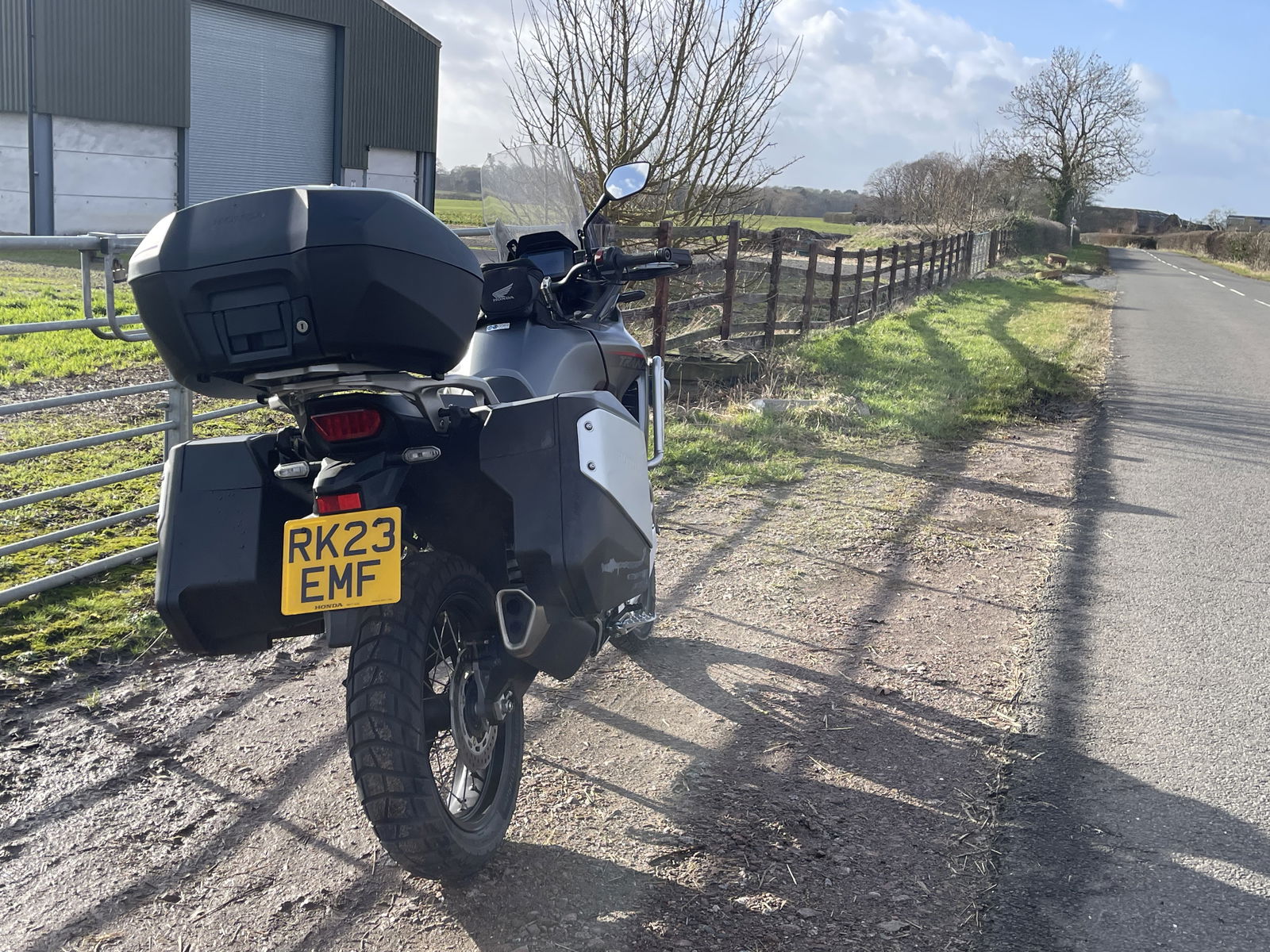
There are a couple of other items on our bike that fall outside of the Plus Pack, namely the excellent quickshifter (which you definitely want) and the bear trap pegs which will only really be of any use if you plan on riding off-road.
Transalp Plus Pack cost
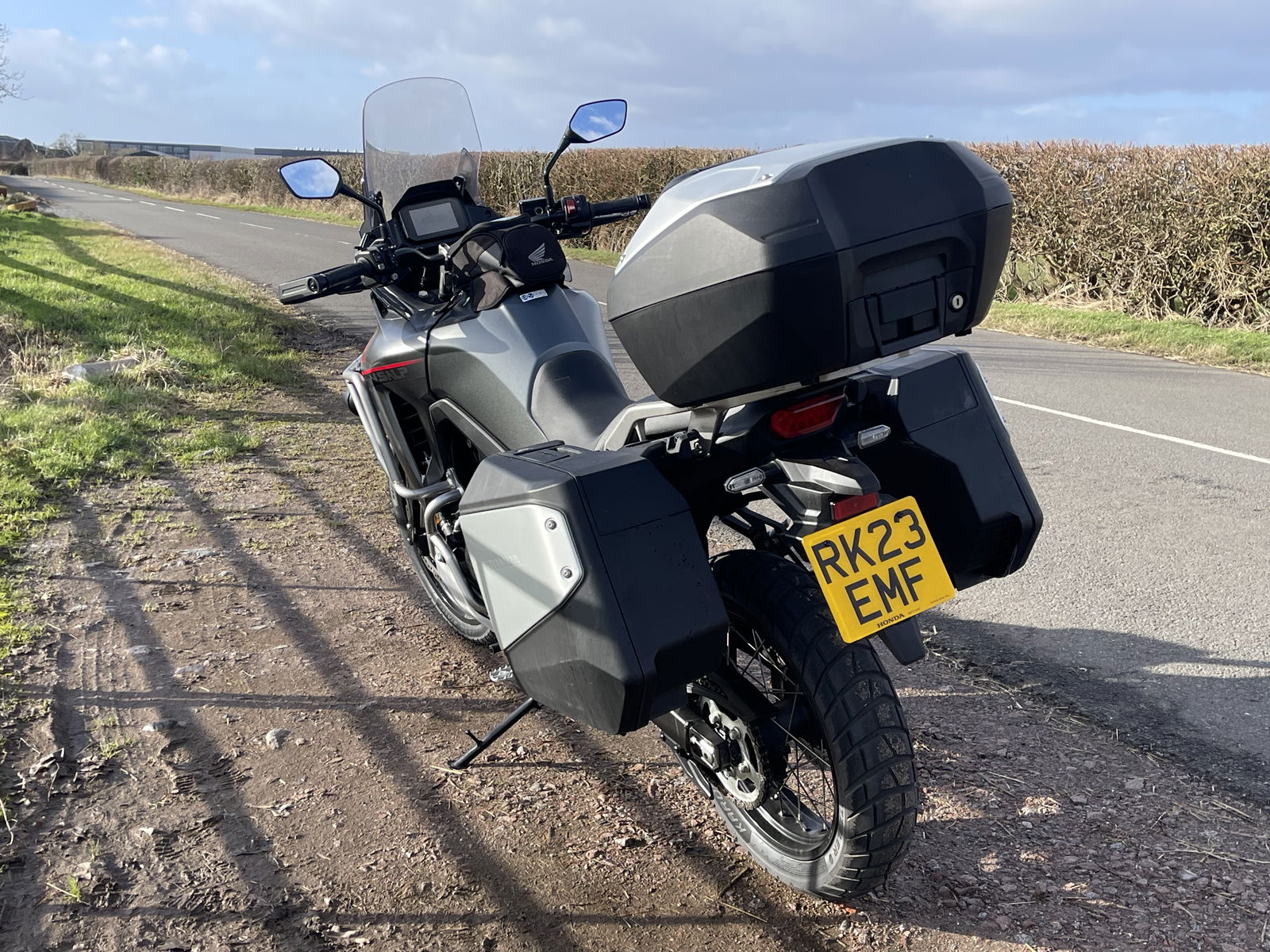
If you buy the Plus Pack from the dealer and fit it to your new bike you can expect to pay £3,685 which is a fair chunk of change, but you are getting a significant pile of goodies and more importantly, all the ones that if you are planning on doing some longer tours will all come in extremely handy.
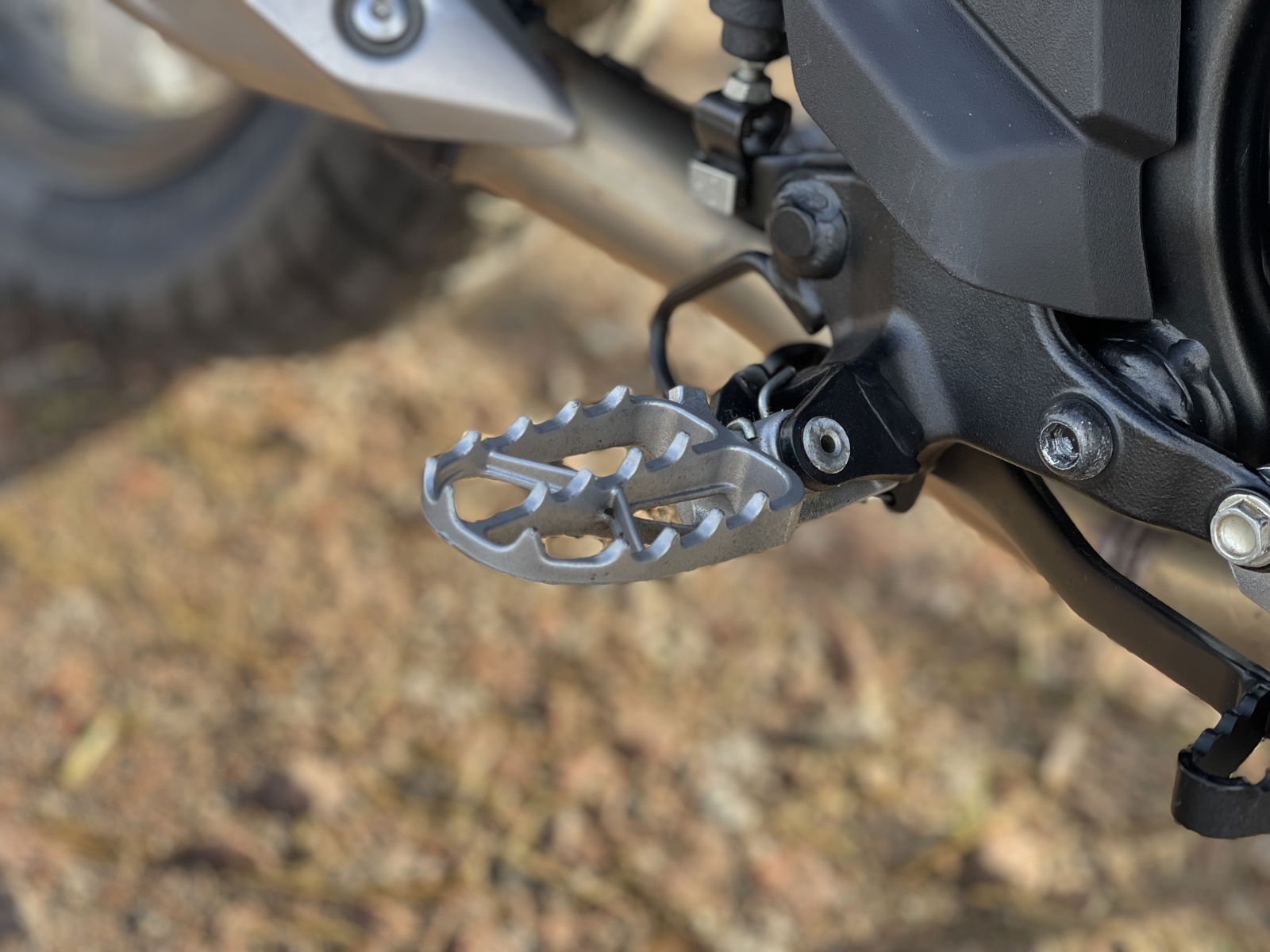
Adding the quickshifter and bear traps onto our bike alongside the Plus Pack nudges the price up to £14,069 from the £9,699 base price. The configurator on the Honda UK website tells me that’ll be coming in at around £215 per month - a more detailed quote would be provided as you move through the process.
Is the luggage any good?

Honda has for a while now moved a few of its models over to what can only be described as more slimline panniers than some other brands. The Japanese company has kept the overall volume of them quite high on both sides, although that does mean you can’t squeeze a full-faced lid on either side. It’s a bonus if you filter through crowded streets regularly, as neither side sticks out any further than the handlebars, not so handy if you are planning on running without the top box and need somewhere safe to stash your helmet.
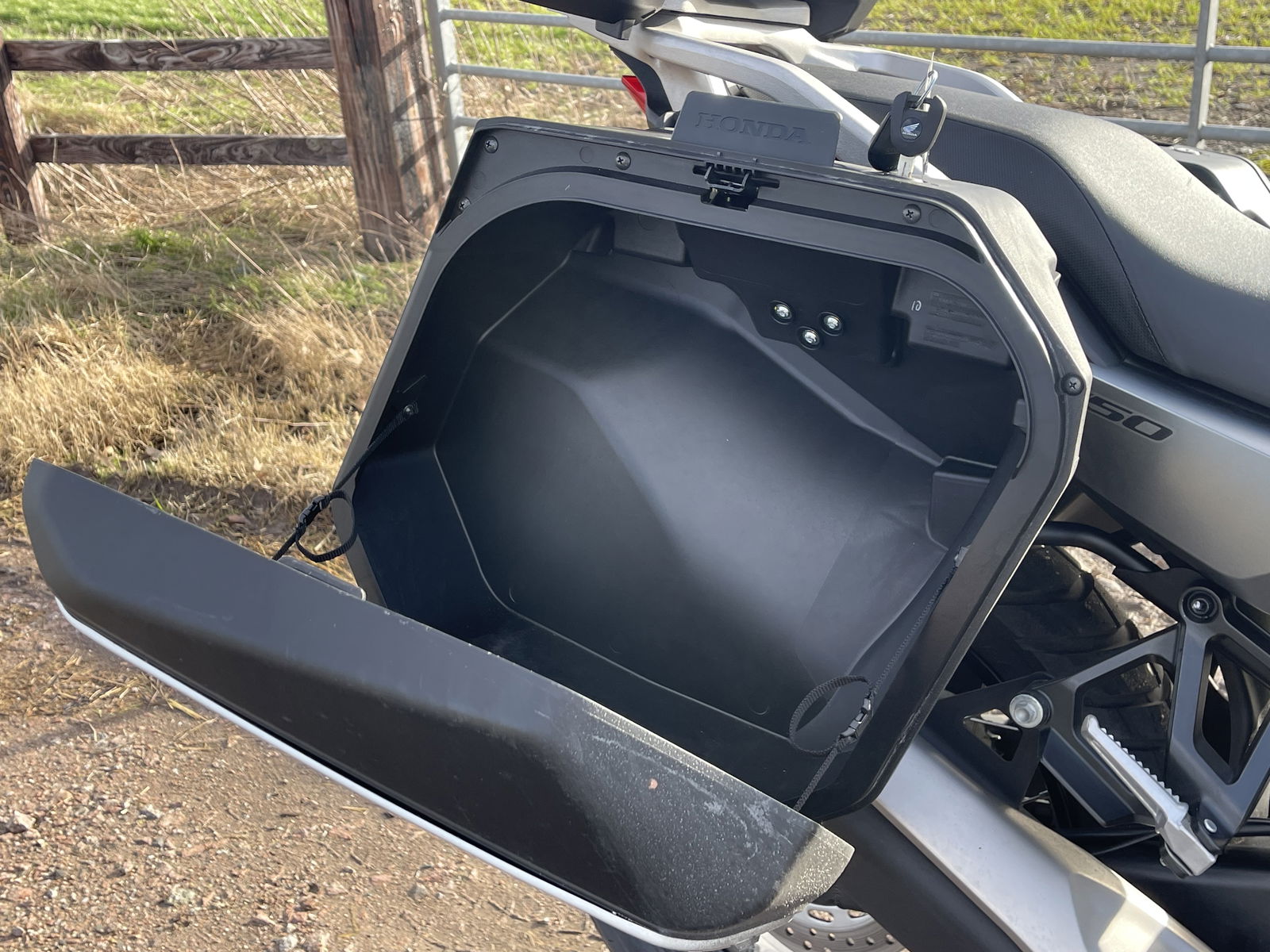
They are though nice enough to use, and the only thing that I’d really think about including if I were buying them myself would be the nice pannier lining bags that make life so much easier when you reach your destination.
The top box is great. It has a fairly sleek design that makes it look less awkward than I’ve seen on some other bikes, and you can fit two full-faced lids in there at the same time without too much bother.
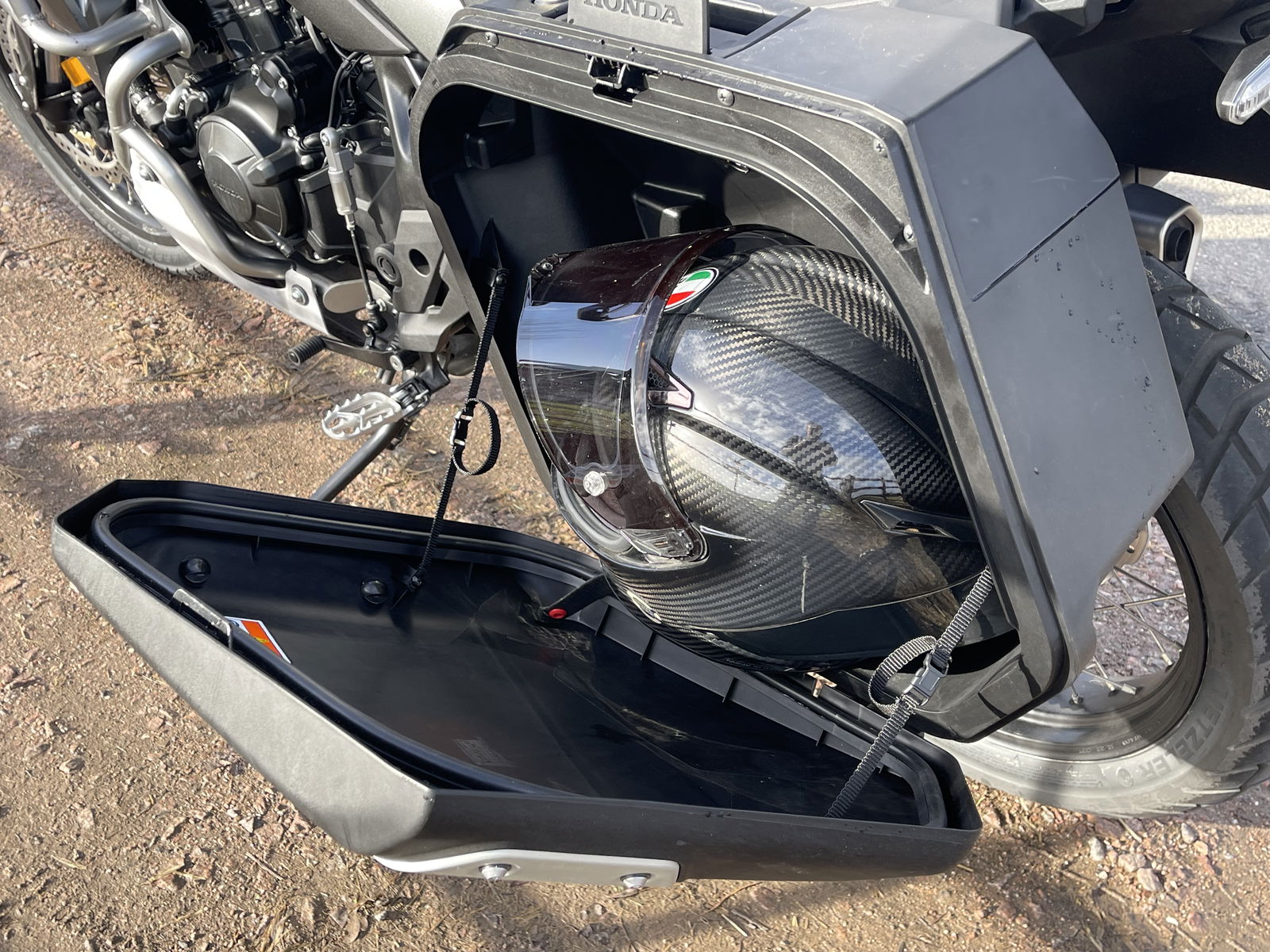
All the panniers lock and unlock off the ignition key for the bike, meaning you don’t have to faff about with multiple keys, and it is also one of the easier sets I’ve encountered when it comes to removing the panniers and remounting them again. This is normally a fairly annoying task that is serenaded by a fair amount of swearing. Not on the Transalp though, and they can be whipped off and reinstalled again in a matter of seconds.
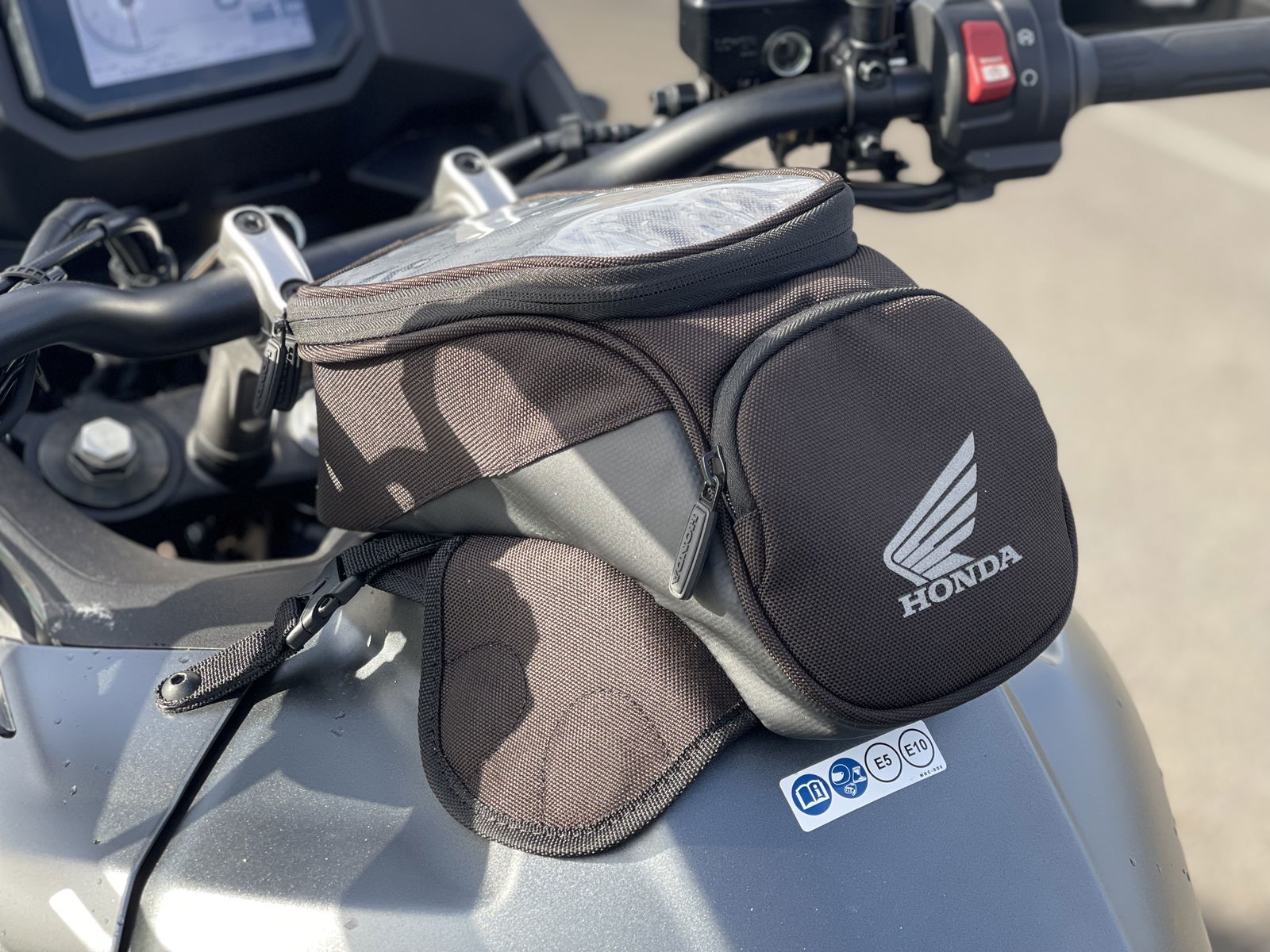
The tank bag on the bike is a fairly small but no doubt handy edition to have while touring. It’s plenty big enough for a couple of phones, a wallet, and travel documents, and includes a see-through window on the top, and an easy-to-install waterproof cover for if the weather turns nasty. The see-through phone pocket is just about big enough for my iPhone 12 Pro Max when it's in a Quadlock case - and that’s about as big as smartphones get! You can remove the tank bag quickly at a fuel stop or when nipping for food by unclicking the buckle fasteners at the front and lifting off the magnetic flaps.
The taller screen is a must-have item - the wind deflectors less so
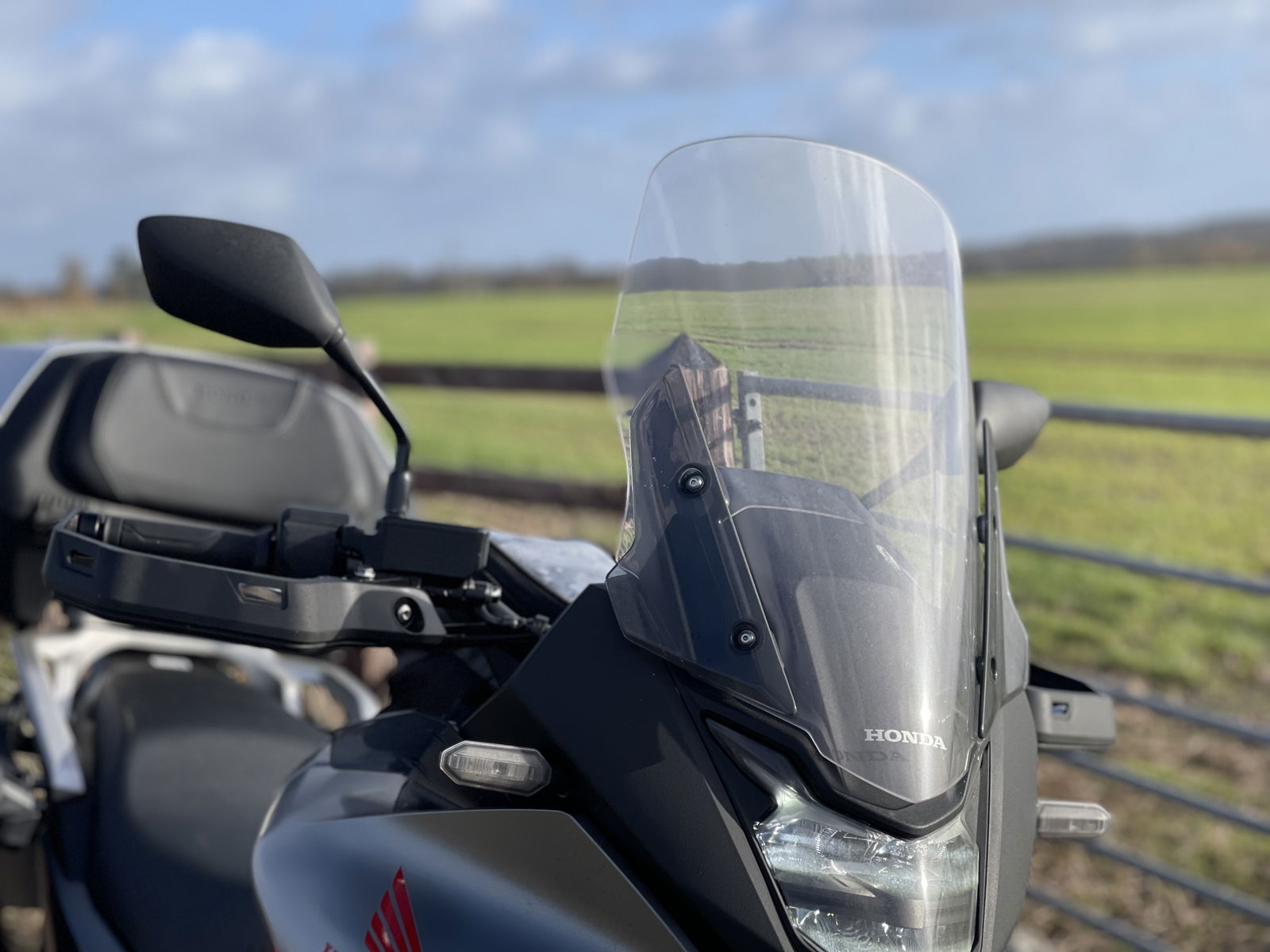
The screen that comes with the Plus Pack is a gem, and it only takes a few hundred yards to begin enjoying the peace and turbulent-free quiet that it introduces to the model. It’s a full 75mm taller than the stock screen and moves the turbulent air well above my head meaning I’m cocooned in a happy little bubble of calm. It’s worth noting that the screen is non-adjustable, and a bit like the screen on the Africa Twin, it sits at such an angle that road grime and muck can quickly build up on it causing me to pull over now and again to give it a clean. The accessory tall screen mounts directly onto the mounting points of the stock screen, meaning if you bought a standalone one you could swap it over in a matter of minutes.
I couldn’t feel the effect of the wind deflectors, and even after a wintery ride in some horrible weather, they didn’t seem to have done much to keep the water and road grime from finding me.
The engine bars look nice, and the fog lamps are great!
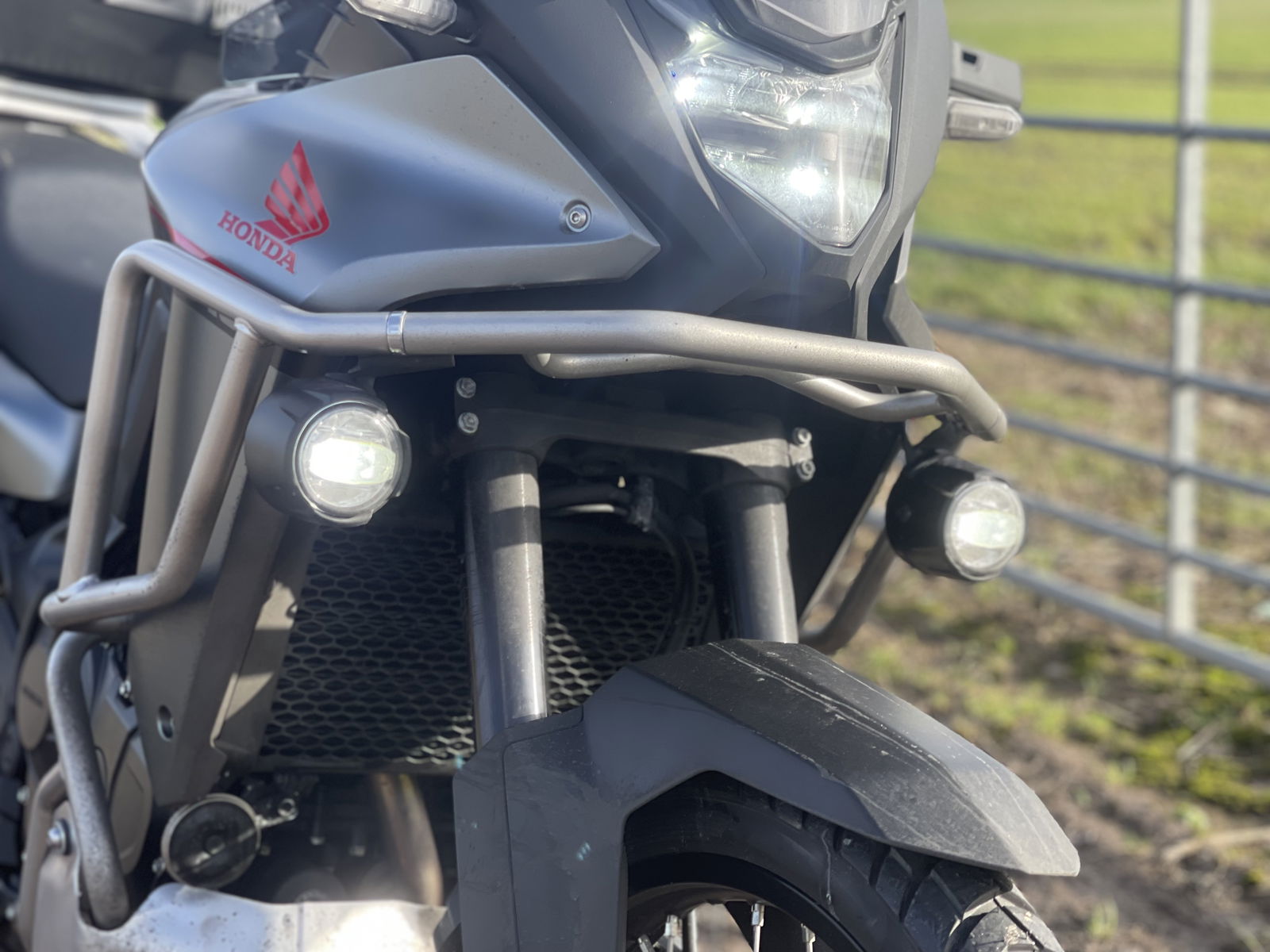
Rounding out the larger of the accessories are the engine crash bars, which comprise upper and lower sections, with the former carrying the mountings for the LED fog lamps. Crash bars on an adventure bike complete the look and help out if you do have a spill on a green lane or trail - or the overflow car park at the local rugby club. The biggest real-world benefit of these though comes with the addition of LED fog lamps, which are excellent at flooding the road immediately in front of the bike with a very helpful amount of light. As the fogs are an accessory there is no hardwired switch to turn them on, and instead, you have to hit the ‘Function’ button (top switch on the left handlebar) and scroll past the heated grips and then toggle the lamps on. Once turned on they will remain in the on position the next time you go to ride the bike, and the fog light symbol will be illuminated on the TFT as a reminder.
Heated grips are great, hand guards could be larger
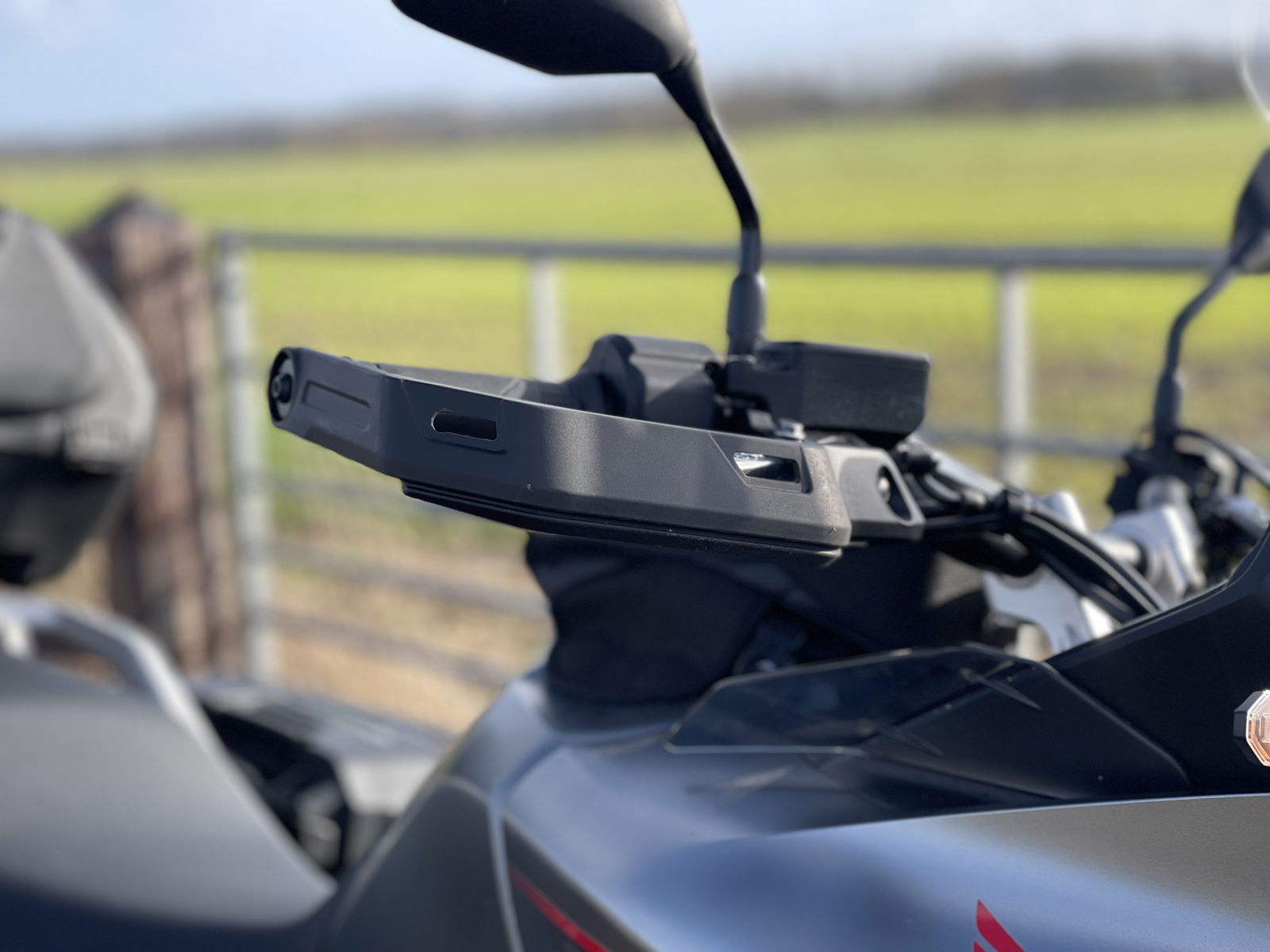
Like the fog lamps, the heated grips are turned on via the function button and they also remain in the ‘on’ position and are set to the same temperature when you return to the bike. They heat up in a matter of minutes and seem to maintain a nice consistent heat regardless of how long you are riding for.

The hand guards are less helpful and seem to be very narrow in their design. I’m sure they would help protect your hands when riding through bushes (or if you took a tumble), but a secondary benefit of having them fitted is they help to keep your hands warm when schlepping up the motorway. To stand any chance of doing that they need to be at least double the size that they currently are.
Should I buy the Honda Transalp Plus Pack

Overall yes, the Plus Pack is a well-thought-out and nicely appointed selection of add-ons that if you are serious about touring or commuting through winter (or both) you’ll find a lot of benefit from. Granted, some elements didn’t perform quite as well as the others, but you are getting a decent discount for buying it all as a pack, and even taking those elements off and buying the rest separately you’d still be paying quite a bit more for the bits you do want.
.jpg?width=1600)
2023 Honda XL750 Transalp specs
ENGINE | |
Engine Type | Liquid-cooled OHC 4-stroke 8-valve parallel twin with 270° crank and Unicam |
Engine Displacement | 755cc |
Bore x Stroke (mm) | 87mm x 63.5mm |
Compression Ratio | 11.0:1 |
Max. Power Output | 67.5kW @ 9,500rpm |
Max. Torque | 75Nm @ 7,250rpm |
Noise Level (dB) | Lwot - 79.4; Lurban - 75 |
Oil Capacity | 3.9L |
Starter | Electric |
FUEL SYSTEM | |
Carburation | PGM-FI electronic injection |
Fuel Tank Capacity | 16.9L |
CO2 Emissions WMTC | 103g/km |
Fuel Consumption | 23km/l (4.4 l/100km) |
ELECTRICAL SYSTEM | |
Battery Capacity | 12v 8.6Ah |
DRIVETRAIN | |
Clutch Type | Wet multiple, assist slipper clutch |
Transmission Type | 6 speed Manual Transmission |
Final Drive | Chain |
FRAME | |
Frame Type | Steel diamond |
CHASSIS | |
Dimensions (L´W´H) | 2,325mm x 838mm x 1,450mm |
Wheelbase | 1560mm |
Caster Angle | 27° |
Trail | 111mm |
Seat Height | 850mm |
Ground Clearance | 210mm |
Kerb Weight | 208kg |
Turning radius | 2.6m |
SUSPENSION | |
Suspension Front | Showa 43mm SFF-CA USD – 200mm travel |
Suspension Rear | Monoshock damper, Pro-Link swingarm, 190mm travel |
WHEELS | |
Wheels Front | 21in (stainless steel) spoked wheels |
Wheels Rear | 18in (stainless steel) spoked wheels |
Tyres Front | 90/90-R21 M/C 54H |
Tyres Rear | 150/70-R18 M/C 70H |
BRAKES | |
ABS Type | 2 channel |
Brakes Front | Dual 310mm x 4.5mm ‘wave’ discs with axial mounted 2 piston calipers |
Brakes Rear | Single 256mm x 6.0mm ‘wave’ disc is operated by a single-piston caliper |
INSTRUMENTS & ELECTRICS | |
Instruments | TFT |
Headlight | LED |
Taillight | LED |
Connectivity | Honda Smartphone Voice Control |
USB | Type C (under the pillion seat) |
12V Socket | Optional |
Auto Winker Cancel | Yes |
Quickshifter | Optional |
Security System | HISS |
.jpg?width=1600)
